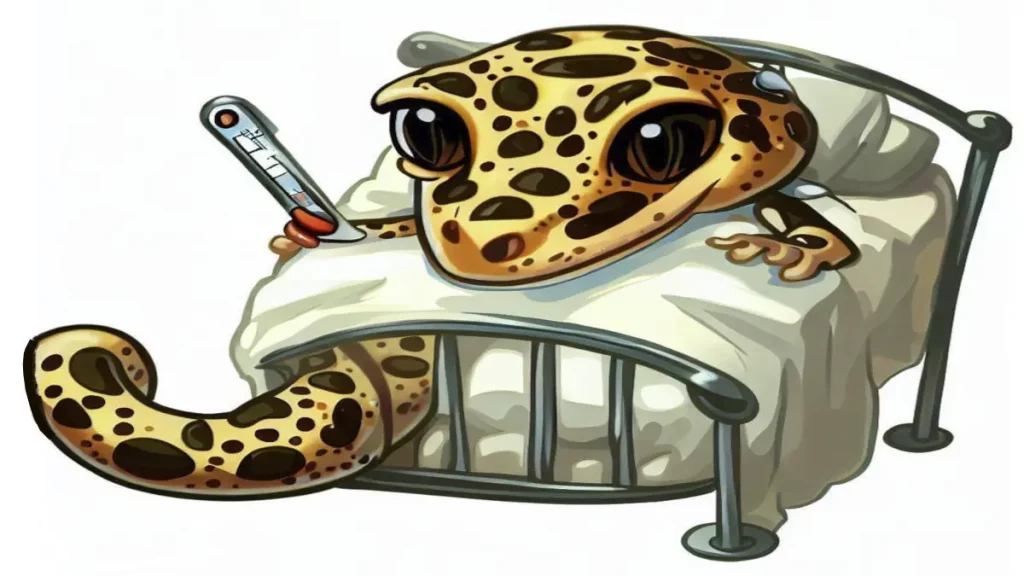
Whether you’re a seasoned pet owner or a first-time leopard gecko enthusiast, understanding potential skin infections is crucial. Just like us, geckos can suffer from skin conditions, and it’s our responsibility to ensure their health and happiness. And skin infections are just one area of leopard gecko diseases and illnesses.
So, let’s delve into the world of gecko skin health.
Decoding Leopard Gecko Skin Conditions
First things first, caring for a leopard gecko isn’t just about providing food and a comfortable home. It’s also about ensuring their environment, or ‘habitat’, is perfectly suited to their needs. This concept, known as ‘proper husbandry’, plays a pivotal role in their health. If overlooked, our scaly friends could face serious skin problems.
Common Skin Infections: Know Your Enemy
Now, let’s unravel some of the skin infections your leopard gecko might encounter.
Dysecdysis: The Shedding Struggle
Ever had a really bad sunburn and your skin started to peel? Well, imagine that, but ten times worse. That’s Dysecdysis. It happens when a gecko can’t shed its old skin properly, which can harm their eyes, nose, and even their limbs.
It’s usually due to an overly dry habitat or an unbalanced diet. So, remember to maintain a humid environment and provide a properly balanced diet.
Bacterial Dermatitis: The Unseen Invader
Next up is Bacterial Dermatitis, a more extensive skin infection caused by harmful bacteria. This usually occurs after a skin injury, allowing bacteria to invade.
Symptoms include lesions that resemble burns or fungal conditions. Proper husbandry is key to preventing this condition, so ensure your gecko’s habitat is clean and safe. No sharp edges or pointy objects they can catch themselves on.
Tail Necrosis: The Tail Tale
Also known as ‘tail rot’, Tail Necrosis is essentially Bacterial Dermatitis in your leopard gecko’s tail. It usually happens when the skin around their tail can’t shed properly, leading to an infection and darkening of the skin. It’s a serious condition that requires immediate attention.
Ulcerative Stomatitis: The Mouth Monster
Also known as mouth rot, Ulcerative Stomatitis is an infection of the gums and mouth that can be caused by small cuts or food stuck in your leopard gecko’s mouth. If left untreated, it can be fatal. So regularly check your leopard gecko’s mouth for any signs of this condition.
Spotting the Signs: Be a Gecko Detective
As a responsible pet owner, it’s important to keep an eye on your gecko’s skin, mouth, eyes, and tail for any signs of these conditions. Regular check-ups and keen observation are key to early detection and treatment.
Healing Hands: Treating Your Gecko
When it comes to mild shedding issues, a gentle splash of warm water and a Q-Tip might do the trick. However, for more serious conditions, it’s best to seek professional help. Your vet will likely prescribe antibiotics and guide you on how to administer them.
Prevention is Better Than Cure
The best way to keep your leopard gecko healthy is to prevent these issues from happening in the first place. Proper husbandry, a balanced diet, and a clean habitat are your best weapons against these skin foes. Keep an eye on your gecko’s habitat temperature and ensure they have the right hides. If humidity is an issue because it’s too dry, line their hide with damp moss. Avoid loose substrate or bedding, and keep sharp objects out of their enclosure. Remember, a clean tank equals a happy gecko!
Questions?
What skin problems do leopard geckos have?
Leopard geckos can face a variety of skin problems, including Dysecdysis (shedding problems), Bacterial Dermatitis (skin infection), Tail Necrosis (tail rot), and Ulcerative Stomatitis (mouth rot). These conditions can be caused by improper husbandry, unbalanced diet, and lack of hygiene in their habitat.
How do you know if your leopard gecko has an infection?
Signs of infection in leopard geckos can vary depending on the type of infection. However, common symptoms include difficulty shedding, small red lesions or blisters on their skin, darkening of the tail, and signs of discomfort in the mouth. If your gecko shows any of these signs or changes in behavior, it’s best to consult a vet.
How do you treat bacterial dermatitis in leopard geckos?
Bacterial Dermatitis in leopard geckos is usually treated with antibiotics prescribed by a vet. It’s also crucial to address the root cause, which often involves improving the conditions of their habitat. This might mean adjusting humidity levels, cleaning the tank more frequently, or removing any sharp objects that could cause skin injuries.
What is skin rot in leopard geckos?
Skin rot, also known as Bacterial Dermatitis, is a skin infection in leopard geckos caused by harmful bacteria. It usually occurs after a skin injury, allowing bacteria to invade. Symptoms include lesions that resemble burns or fungal conditions. It’s a serious condition that requires immediate attention and treatment.
How can I prevent skin infections in my leopard gecko?
Preventing skin infections in leopard geckos involves proper husbandry, a balanced diet, and a clean habitat. Ensure their habitat has the right temperature and humidity levels, provide a balanced diet, and keep their tank clean. Regular check-ups and keen observation can also help detect any potential issues early.
In Conclusion
Being a responsible leopard gecko owner involves more than just providing food and shelter. It’s about understanding their health needs, recognizing signs of potential problems, and taking appropriate action. With the right knowledge and care, you can ensure your leopard gecko lives a long, happy, healthy life.
Read more about other leopard gecko health problems:-

![Leopard Gecko Skin Infections [How To Spot Them & What To Do]](https://cdn.leopardgeckoland.com/wp-content/uploads/2023/06/sick-leopard-gecko-1200x640.webp)

![Leopard Gecko Metabolic Bone Disease [Gecko Owners Guide]](https://cdn.leopardgeckoland.com/wp-content/uploads/2023/07/gecko-in-bed-with-mbd-440x264.webp)











